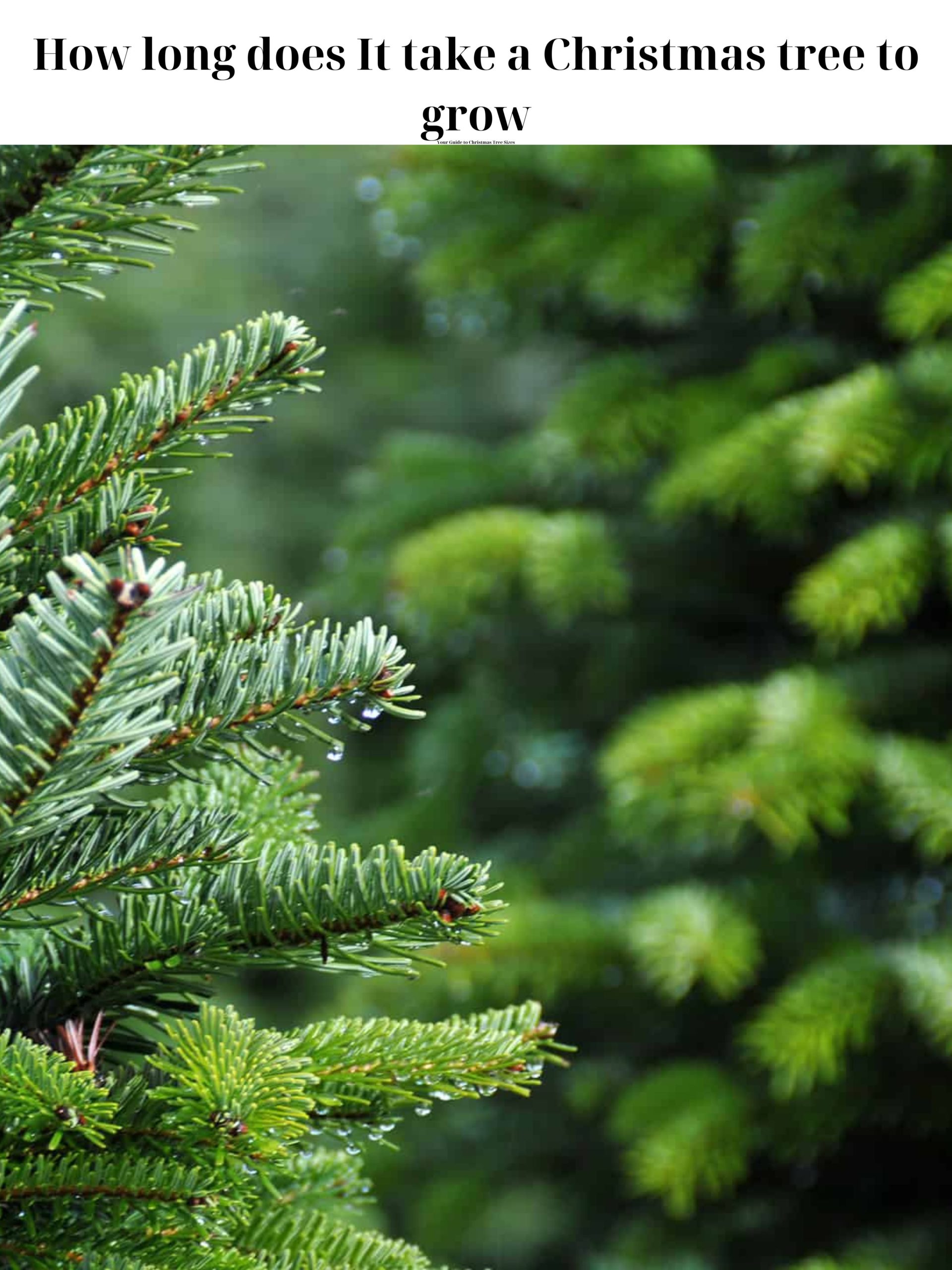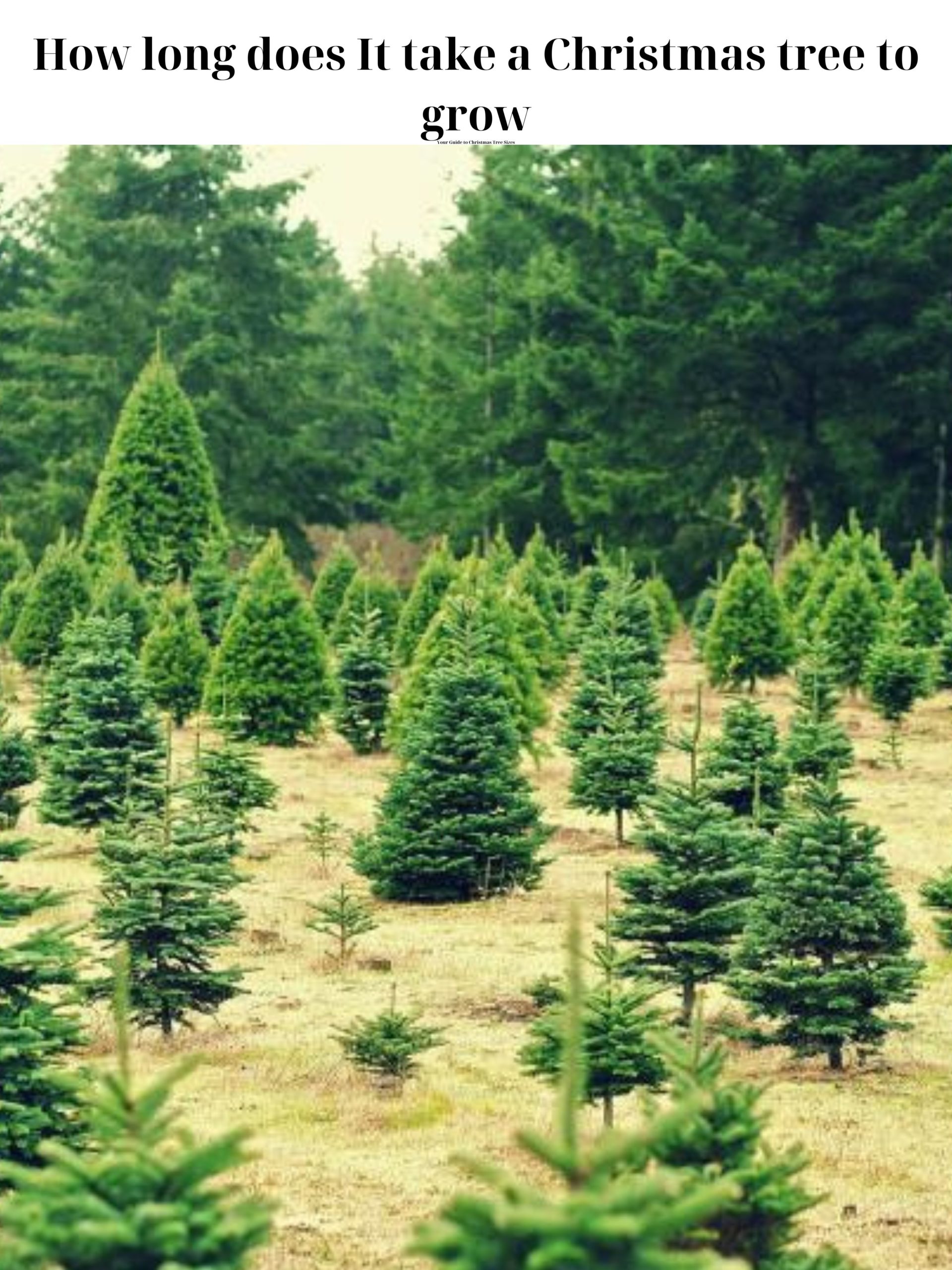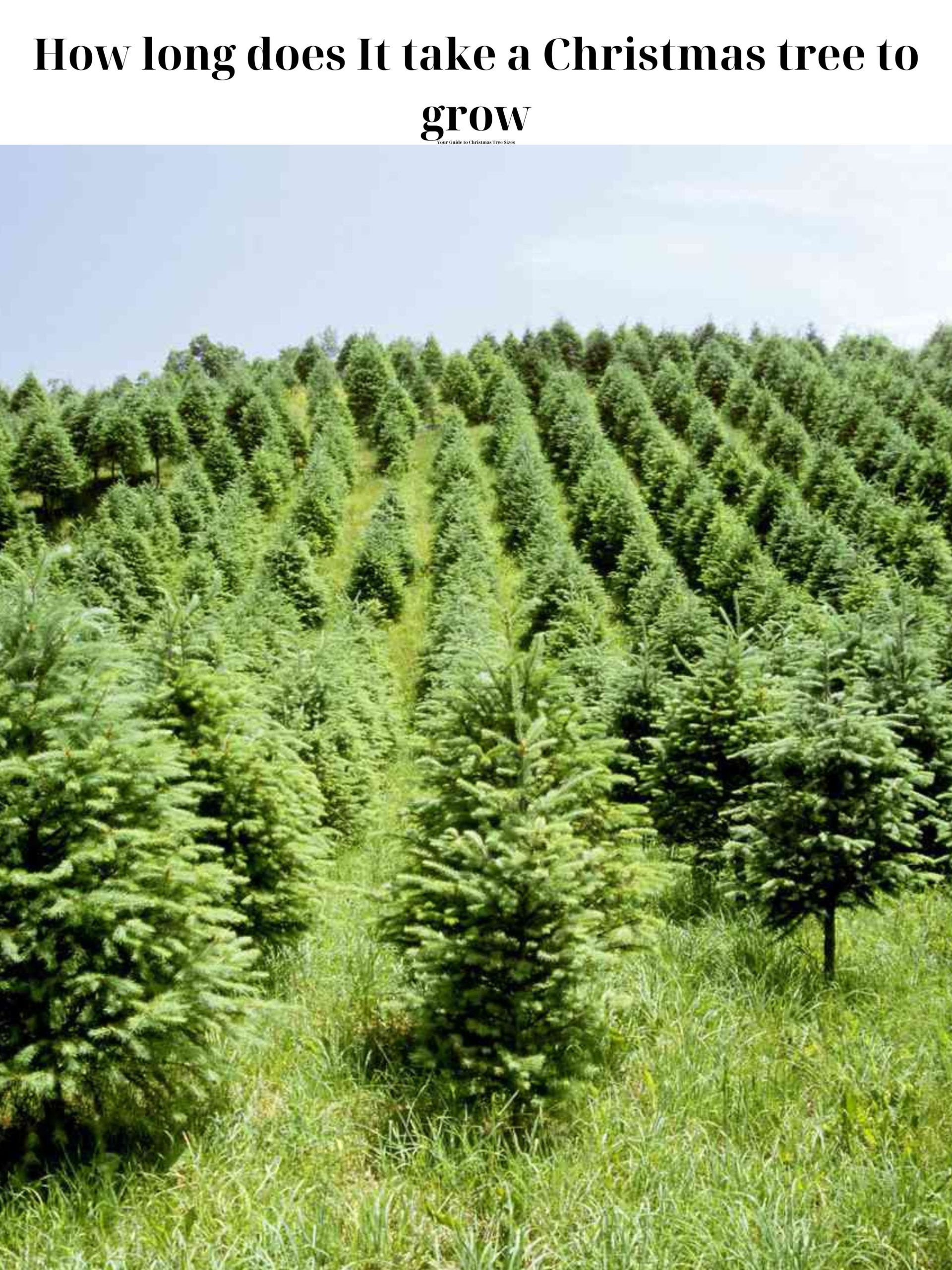What Is the Average Time for a Christmas Tree to Grow
Different types of trees like fir, pine, spruce, cypress, and cedar are commonly used for Christmas decorations worldwide. In the Southern states, Fraser fir, Douglas fir, and Leyland cypress are particularly popular. Each tree species has unique soil and water requirements, resulting in different growth rates.
According to the National Christmas Tree Association, growing a tree of typical height (six to seven feet) can take as little as four years or as long as 15 years. On average, it takes around seven years for a Christmas tree to reach its desired height.

What Factors Affect the Growth of a Christmas Tree
The growth of a Christmas tree is influenced by a multitude of factors. One of the most important variables is the species of the tree. Some species of trees grow faster than others and can be harvested sooner.
– Light and humidity levels also play a crucial role in a tree’s growth. Trees require a lot of light to thrive, but direct sunlight can also damage them.
– Similarly, the right amount of humidity is also essential for healthy growth. Soil conditions are also crucial, as trees require nutrient-rich soil to grow. Proper fertilization is essential and can significantly prolong the life of a Christmas tree.
– Furthermore, the age and size of the tree also influence its overall growth. Younger trees will grow faster, while older trees will typically take longer to reach their full potential.
Tips on Growing a Healthy Christmas Tree
- Choose the right species: Different tree species have different preferences in terms of soil type, moisture level, and sun exposure. Consider the climate and geographic region you reside in and select a tree species that fits those conditions.
- Plant in the right location: Trees need plenty of space to grow and reach their full potential. Ensure you select a location with adequate space to foster healthy growth and development, taking into account future growth and the light requirements of the chosen species.
- Adequate watering: Trees need regular and consistent watering to maintain their growth and health. Trees should be watered deeply once or twice a week during the growing season, with a total of 1-1.5 inches of water each week.
- Fertilizing: Regular fertilizing is necessary to maintain healthy growth and development of the tree. In general, mature trees require one pound of nitrogen per 1000 square feet of growing area annually. Use a slow-release nitrogen fertilizer to avoid causing stress and damage to the roots.
- Regular pruning: Proper pruning is essential in encouraging healthy growth and development. Prune regularly to eliminate any damaged, diseased, or weak branches. This will allow the tree to focus its energy on healthy growth and development.
- Protect from pests and diseases: Trees are susceptible to a variety of pests and diseases, which can cause irreversible damage or death. Inspect the tree regularly and take preventative measures to minimize the risk of pests and diseases by using organic pesticides or natural remedies.

Factors That Affect the Growth Rate of a Christmas Tree
What Type of Soil Is Best Suited for Growing Christmas Trees
The ideal soil for a Christmas tree plantation should have good drainage and be able to retain moisture efficiently. This type of soil should also be rich in organic matter, and be pH balanced to provide the necessary nutrients for healthy tree growth.
Sandy loam soil is often recommended by experts as the best soil type for growing Christmas trees, as it provides ample drainage and is easy to work with. Additionally, soil with a pH level of 6.0 to 7.5 can stimulate growth and help the trees maintain good health.
How Much Water is Needed to Grow a Healthy Christmas Tree
Watering your Christmas tree adequately is a must, but the exact amount can differ based on factors like its species, size, and your local weather. Generally, a Christmas tree needs about one quart of water daily for every inch of trunk diameter.
So, if you’ve got a six-foot tree with a three-inch diameter trunk, it would require roughly three quarts of water each day. If your tree doesn’t get enough water, you might notice dry needles, drooping branches, and the tree may not last as long.
The National Christmas Tree Association shares that a well-hydrated tree could stay fresh for four weeks or even longer. It’s crucial to keep the tree stand’s water reservoir full and keep a close eye on the water level every day, especially during the first few days after you bring the tree home. That’s when it’s going to be the most thirsty.
A handy tip is to add things like aspirin or sugar to the water. This can help the tree absorb water more effectively and keep it looking fresh for longer. Also, to take a look at the Christmas tree Black Friday sales – you might find a great deal on your perfect tree!
What Climate Is Most Ideal For Growing A Christmas Tree
These trees require a cool, moist environment to thrive, with temperatures ranging between 20 to 40 degrees Fahrenheit. In general, areas with relatively high rainfall, with an average of 20 to 40 inches annually, are also ideal for growing Christmas trees. Areas with deep and relatively fertile soil are highly recommended for Christmas tree cultivation.
Also, the best time to plant a Christmas tree is in the fall, ideally before the first frost. With proper care, the ideal climate can ensure that the Christmas tree grows healthy and lasts a long time. However, it’s worth noting that different types of Christmas trees can grow in various climates, and an individual farmer’s preference and their region’s climate are the two most critical factors in determining the best species of trees for them to grow.

Different Types of Christmas Trees and Their Lifespans
- Balsam Fir – The balsam fir is a popular choice for Christmas trees due to its vibrant green color and pleasing aroma. It typically lasts around four to six weeks with proper care.
- Douglas Fir – The Douglas fir is a symmetrical tree with blue-green needles and a cone shape. It can last up to six weeks with proper care.
- Fraser Fir – The Fraser fir is a popular tree known for its strong branches, making it ideal for hanging heavy ornaments. With proper care, it can last up to six weeks.
- Noble Fir – The Noble fir has strong branches and a classic Christmas tree shape. It typically lasts around six to eight weeks with proper care.
- Scotch Pine – The Scotch pine is an attractive tree known for its sturdy branches and bright green needles. It typically lasts around four to five weeks with proper care.
- Virginia Pine – The Virginia pine is a popular tree due to its bushy appearance and pleasant fragrance. It can last up to four weeks with proper care.
- White Pine – The white pine has soft, blue-green needles and a graceful, delicate appearance. It typically lasts around three to four weeks with proper care.
Fast-Growing Christmas Trees
Leyland Cypress
Leyland Cypress is a dry variety of cypress known as Cupressus leylandii. It is frequently used as a Christmas tree in the southern United States. In suitable conditions, Leyland cypress can grow rapidly, with young trees often reaching a height of three feet per year.
Arizona Cypress
Arizona cypress, also known as Hesperocyparis arizonica, is a type of cypress that thrives in the states of Arizona and West Texas. It can also be grown successfully in southeastern states such as Louisiana, Mississippi, Alabama, parts of the Florida panhandle, and North Carolina.
Average-Growing Christmas Trees
Fraser Fir
The Fraser fir tree is a beloved Southern favorite that thrives in the southern Appalachian region, particularly in North Carolina, Virginia, and Tennessee. According to the National Christmas Tree Association, it typically takes around seven years for a Fraser fir tree to grow to an average height of six to seven feet.
Canaan Fir
Canaan Fir is an evergreen tree species (scientific name: Abies balsamea var. phanerolepies) that can be found in Virginia and West Virginia. It grows at a moderate pace of two to three feet per year, similar to Fraser and balsam firs.
Slow-Growing Christmas Trees
Eastern Redcedar
The Eastern redcedar, scientifically known as Juniperus virginiana, is actually a juniper and not a cedar, contrary to its name. It has a moderate growth rate of approximately one to two feet per year when planted. This specific type of tree is commonly found in Texas and Oklahoma, but it can also be found in areas beyond the South. The Eastern redcedar plays a significant role in the natural landscape, providing several versatile uses and benefits in everyday life.
Virginia Pine
Virginia pine, also known as Pinus virginiana, has a slow growth rate, according to the University of Kentucky Department of Horticulture. However, under favorable conditions, this species can grow up to 40 feet tall and 30 feet wide. It is primarily found in Virginia and Kentucky but can also be found in other southern states like Tennessee, Mississippi, and Alabama.
Lifespan Of Live, Cut-Down, And Pre-cut Christmas Trees
Proper care, including regular watering and keeping the tree away from heat sources, can help extend its lifespan. On average, a live Christmas tree can last between 3-4 weeks.
Cut-down trees have a shorter lifespan compared to live trees, as they are already dead when they are cut down.
Typically, a cut-down tree can last between 2-3 weeks, depending on how fresh it was when harvested.
Pre-cut Christmas trees, which are harvested earlier in the year, tend to have the shortest lifespan of all. These trees can last between 1-2 weeks, depending on when they were cut and how well they were cared for during transport and storage.
Benefits Of Buying A Real vs Artificial or Pre-cut Tree
Growing Christmas trees brings numerous benefits to both the environment and our local communities. Walking among the trees fills me with joy, as I savor the refreshing scents of pine, spruce, cypress, cedar, and fir. These magnificent trees not only provide a heavenly experience but also play a vital role in carbon storage and oxygen production. They improve the environment by stabilizing soil, safeguarding water supplies, and creating habitats for wildlife.
When we choose a real Christmas tree, we support sustainable practices. These trees are mostly grown on land that is unsuitable for other crops, helping to conserve valuable forests by reducing the need to harvest trees from the wild. In contrast, artificial trees, primarily manufactured in Chinese factories, are made from petroleum-based materials. Once discarded, they contribute to landfill waste and take centuries to decompose.
It’s heartening to know that the Christmas tree industry in the United States generates more than 100,000 jobs while providing a sense of local support. Every state, including Hawaii, cultivates Christmas trees, contributing to the economy and fostering a cherished tradition. This year alone, over 35 million trees will be cut and replanted, ensuring the continuation of this beautiful tradition for years to come.

Common Mistakes To Avoid When Growing Your Own Tree
1. Choosing the wrong planting site
This mistake can lead to poor growth, damage from wind or sun exposure, and susceptibility to pests and diseases. Make sure to choose a site that has adequate drainage, receives enough sunlight, and has enough space for the tree to grow without competing with other plants.
2. Neglecting tree condition and selection
It’s important to choose a tree that is healthy and suited for your climate and soil type. Neglecting to do so can result in stunted growth, poor fruit or flower production, and susceptibility to pests and diseases.
3. Planting too deep
If you plant your tree too deep, its roots can suffocate and the tree may not be able to take up enough water and nutrients. Make sure you plant your tree at the right depth by covering the top of the root ball with soil but not the trunk.
4. Digging a hole too small
A small planting hole can restrict root growth, leading to poor tree development and susceptibility to drought. Make sure to dig a hole that is at least twice the width of the root ball.
5. Improper watering
Too much or too little water can harm your tree. Be sure to water your tree deeply and infrequently to promote deep root growth and avoid standing water that can cause root rot.
6. Staking trees unnecessarily or incorrectly
Staking can help young trees establish a strong root system, but over-staking can lead to weak trunk development. Only stake your tree if it is necessary to keep it from falling over and make sure the stake is not too tight, as it can damage the trunk if left on for too long.

Most popular type of Christmas tree
The most popular Christmas tree in the UK is the Nordmann fir. According to the British Christmas Tree Growers Association (BCTGA), approximately 80% of Christmas trees purchased in the UK are Nordmann firs. They are favored for their vibrant green color and minimal needle shedding leading up to Christmas Day.
To maintain the tree’s health, proper care is necessary. With good care, a Nordmann fir can stay fresh and vibrant until early January.

Hi, my name is Phillip K. Weddle and I am the CEO of christmastreeblackfriday. I was born on May 18, 1966, and I currently reside at 2705 Bassel Street in Harahan, LA 70123. Being a Taurus, I am someone who is grounded, dependable, and enjoys the finer things in life. Before becoming the CEO, I worked as a Mold and Model maker at Robert Hall. However, my true passion lies in gardening, decoration, and DIY stuff, which is why I started this website. I wanted to bring together my love for the holidays and my enthusiasm for decoration and offer the best deals on Christmas trees at Black Friday.

